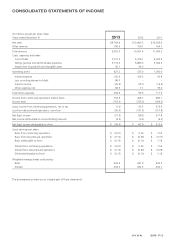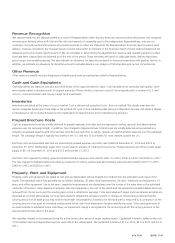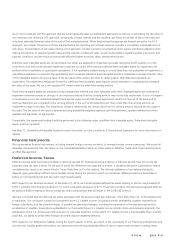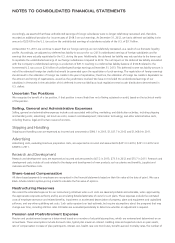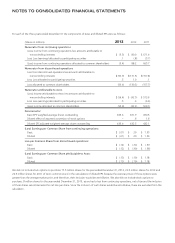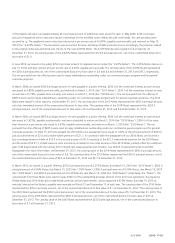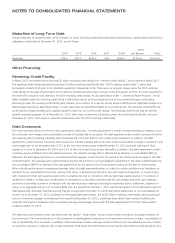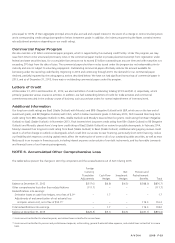Avon 2013 Annual Report Download - page 83
Download and view the complete annual report
Please find page 83 of the 2013 Avon annual report below. You can navigate through the pages in the report by either clicking on the pages listed below, or by using the keyword search tool below to find specific information within the annual report.associate retirements, the number of associates electing to take lump-sum payments and other factors. Actual results that differ from
assumptions are accumulated and amortized to expense over future periods and, therefore, generally affect recognized expense in future
periods. We are required, among other things, to recognize the funded status of pension and other postretirement benefit plans on the
balance sheet. Each overfunded plan is recognized as an asset and each underfunded plan is recognized as a liability. The recognition of
prior service costs or credits and net actuarial gains or losses, as well as subsequent changes in the funded status, are recognized as
components of accumulated other comprehensive income, net of tax, in shareholders’ equity, until they are amortized as a component of
net periodic benefit cost. We recognize prior service costs or credits and actuarial gains and losses beyond a 10% corridor to earnings based
on the estimated future service period of the participants. The determination of the 10% corridor utilizes a calculated value of plan assets for
our more significant plans, whereby gains and losses are smoothed over three- and five-year periods. We use a December 31 measurement
date for all of our employee benefit plans.
Contingencies
We determine whether to disclose and/or accrue for loss contingencies based on an assessment of whether the risk of loss is remote,
reasonably possible or probable. We record loss contingencies when it is probable that a liability has been incurred and the amount of loss is
reasonably estimable.
Out-of-Period Items
During the first quarter of 2012, we recorded an out-of-period adjustment which decreased earnings by approximately $14 before tax ($10
after tax) which related to 2011 and was associated with bad debt expense in our South Africa operations. We evaluated the total out-of-
period adjustments impacting 2012 of approximately $13 before tax ($15 after tax), both individually and in the aggregate, in relation to the
quarterly and annual periods in which they originated and the annual period in which they were corrected, and concluded that these
adjustments were not material to the consolidated annual financial statements for all impacted periods.
During the first quarter of 2011, we determined that the net after-tax gain on sale of Avon Products Company Limited (“Avon Japan”),
reported in our financial statements for the year ended December 31, 2010, should have been reported as a net after-tax loss of
approximately $3, to correctly include all balances relating to Avon Japan that were previously included in accumulated other comprehensive
loss (“AOCI”). In addition, in the first quarter of 2011 the Company released a liability relating to a previously owned health care business,
which should have been released in a prior period, resulting in an approximate $4 increase in net income. The results of these businesses
were originally reported within discontinued operations upon disposition. The net impact of these two items decreased net income for the
first quarter of 2011 by approximately $9. We also identified and recorded other various out-of-period adjustments during 2011 (primarily
related to cost of sales and selling, general and administrative expenses) that related to prior years. The net impact of these other items
decreased net income for 2011 by approximately $14. We evaluated the total out-of-period adjustments impacting 2011 of approximately
$23, both individually and in the aggregate, in relation to the quarterly and annual periods in which they originated and the annual period in
which they were corrected, and concluded that these adjustments were not material to the consolidated annual financial statements for all
impacted periods.
See Note 19, Results of Operations by Quarter (Unaudited), for discussion of these and other out-of-period adjustments within 2012 and
2011 and their impact on the interim periods.
(Loss) Earnings per Share
We compute (loss) earnings per share (“EPS”) using the two-class method, which is a (loss) earnings allocation formula that determines (loss)
earnings per share for common stock and participating securities. Our participating securities are our grants of restricted stock and restricted
stock units, which contain non-forfeitable rights to dividend equivalents. We compute basic EPS by dividing net (loss) income allocated to
common shareholders by the weighted-average number of shares outstanding during the year. Diluted EPS is calculated to give effect to all
potentially dilutive common shares that were outstanding during the year.
A V O N 2013 F-13


